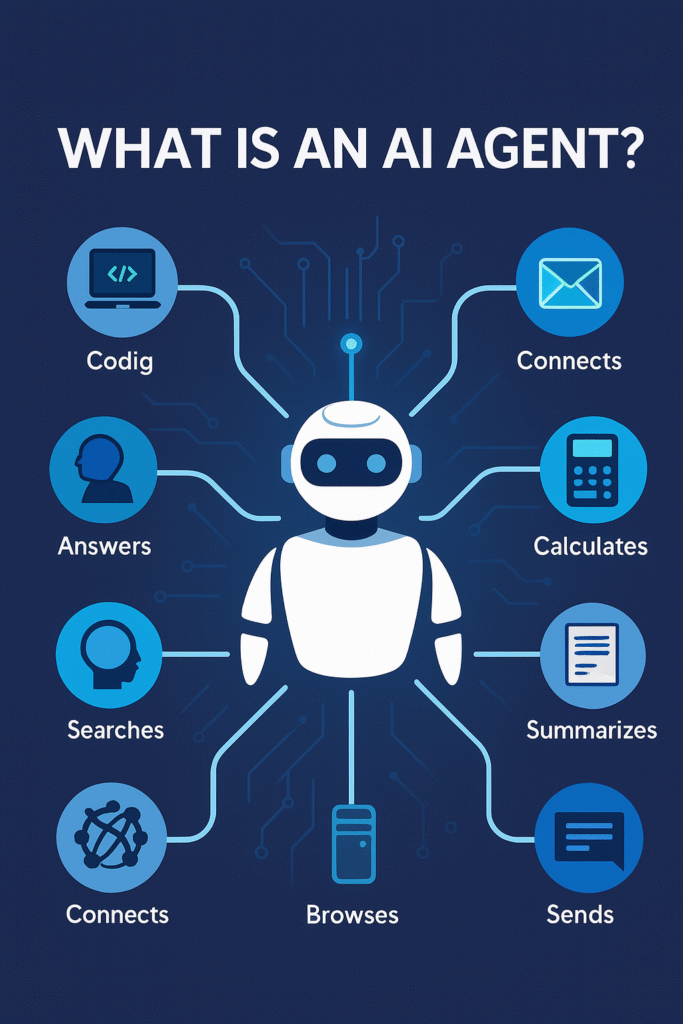AI Agents 2025: The Dawn of Autonomous AI
AI Agents 2025 are changing everything about work. The generative AI hype train isn’t slowing down—it’s morphing. In 2025, it’s less about fancy chatbots and more about what those bots can do on their own. The world’s biggest AI players—OpenAI, Google, Meta, Anthropic—aren’t just competing on who can write the best essay. The real flex is building AI that can actually take action, automate workflows, and basically run parts of your business without a human in the loop (CVPR 2025).
Signals are everywhere. Major conferences like CVPR broke records in submissions and demos, and the new gold rush is “agents”—AI models that don’t just talk, but get things done (OpenAI, 2025).
The Shift: From Language Models to AI Agents 2025
Let’s get one thing straight: LLMs (think ChatGPT, Gemini, Claude, Llama) are dope at writing, summarizing, answering, and analyzing. But that’s a passive role. The real leap with AI Agents 2025 is autonomous AI agents—tech that can execute tasks across apps, chain together actions, trigger workflows, and manage whole business processes without babysitting.
AI Agents—sometimes called Large Action Models (LAMs)—are LLMs leveled up. They manage control flow, tap APIs, search, retain context, and even select which tools to use for a job (Anthropic, 2025). This isn’t just about having a better chatbot. It’s about having digital coworkers that can onboard new hires, process invoices, or debug code while you sleep.
Quick breakdown:
| LLMs (e.g. ChatGPT) | AI Agents 2025 (e.g. Agentforce) | |
|---|---|---|
| Main Use | Text generation, Q&A | Action, automation, workflows |
| Output | Words, summaries | API calls, software actions |
| Autonomy | Reactive, needs prompts | Proactive, needs objectives |
| Example | Gemini, Claude | OpenAI GPTs, Agentforce |
It’s a whole new paradigm. LLMs are the “brain,” but agents are the hands, feet, and everything in between.
How AI Agents 2025 Are Disrupting the Ecosystem: No-Code, Low-Code, and Beyond
You don’t need a CS degree to deploy this stuff. The AI Agents 2025 ecosystem is wild—no-code, low-code, and full-stack options for any user or company:
- OpenAI GPTs: No-code, plug-and-play agents for knowledge management and productivity (OpenAI, 2025).
- Salesforce Agentforce: Enterprise-level, low-code platform with killer CRM integration.
- Assistants.ai: Drag-and-drop agent builder for automating business workflows.
- Glide: For building full apps with AI agents under the hood.
- Zapier Agents: Connect and automate apps with minimal effort.
- LangChain: For devs who want max flexibility and deep customization.
This is real “democratization of AI”—not just for Big Tech, but for startups, SMBs, and even solo operators (Glide, 2025).
Real-World Impact: AI Agents 2025 Are Already Running the Show
This isn’t some “AI in 2040” fantasy. AI Agents 2025 are working right now, across every sector that matters:
- Software Dev: Generate code, review pull requests, fix bugs, and handle deployments (Scrums.com, 2025).
- HR: End-to-end employee onboarding, contract management, and candidate screening.
- Finance: Automated invoice processing, compliance checks, reconciliations, and even investment research.
- Healthcare: Appointment scheduling, digital symptom checking, insurance verification, claims management.
- Retail/Ecomm: Real-time order tracking, personalized upselling, complaint resolution, returns/refunds, loyalty management.
- Manufacturing: Predictive maintenance, supplier management, logistics and inventory.
- Public Sector: Citizen chatbot support, internal HR/payroll automation, feedback collection.
- Travel/Transport: Automated rebooking, customer service, baggage tracking, itinerary planning.
- Telecom/Utilities: Outage reporting, billing support, fraud checks, technician scheduling.
Long story short: AI agents don’t just automate simple tasks—they orchestrate entire processes, adapt to feedback, and get smarter over time (Salesforce, 2025).
Why Now? Because AI Agents 2025 Raise the Stakes
What’s pushing this hard pivot from LLMs to AI Agents 2025?
- Insane competition—every company is desperate to build the next must-have agent.
- FOMO—nobody wants to be the dinosaur left behind using 2023’s tech.
- Economic pressure—AI agents drive real productivity and cut costs, fast.
- Tech is ready—no-code and low-code platforms killed the last barriers for non-coders (OpenAI, 2025).
But Don’t Get It Twisted: Real Challenges Remain
Let’s keep it real—AI agents are not magic wands:
- Data Quality: Garbage in, garbage out. Bad data kills agent performance.
- Bias: Agents can easily inherit and amplify historical biases. Huge risk, especially in HR, lending, and law (Anthropic, 2025).
- Legacy Integrations: Older systems don’t always play nice.
- Scale: Peak usage can crash weak setups.
- Context/Intent: Agents still mess up nuanced requests. Far from solved.
- Security: New attack surface, more vulnerabilities.
- Cost: Custom agent solutions still require real investment.
- Explainability: “Black box” decisions? Not a good look in regulated industries.
Best practices:
- Define clear, measurable goals.
- Clean, diverse data is non-negotiable.
- Bake in human oversight (human-in-the-loop).
- Prioritize security and compliance.
- Start small, iterate fast.
TL;DR—The Agentic Future Is Here
The AI agent revolution is real, and it’s happening now. AI Agents 2025 are no longer sidekicks—they’re taking on center-stage work in every major industry. Companies leveraging these tools today are already winning on speed, efficiency, and innovation.
If you’re still sleeping on AI agents, you’re not just missing a trend—you’re risking irrelevance. The smartest move in 2025? Start experimenting, pick a workflow, and deploy an agent. Just don’t forget the human touch.

